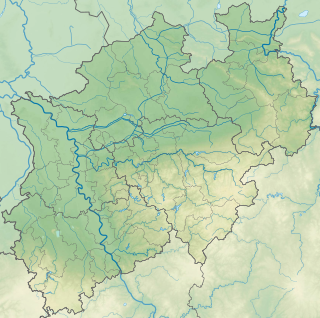Lenneper plateaus
| Lenneper plateaus | |||
|---|---|---|---|
| Typical landscape in the southeast of Wuppertal | |||
| Systematics according to | Handbook of the natural spatial structure of Germany | ||
| Greater region 1st order | Low mountain range threshold | ||
| Greater region 2nd order | Rhenish Slate Mountains | ||
| Main unit group | 33 → Süderbergland |
||
| About main unit | 338 → Bergische plateaus |
||
| 4th order region (main unit) |
338.1 → Bergisch-Märkische plateaus |
||
| Natural space |
338.10 → Lenneper plateaus |
||
| Geographical location | |||
| Coordinates | 51 ° 13 '4 " N , 7 ° 17' 14" E | ||
|
|||
| local community | Remscheid , Wuppertal , Hückeswagen | ||
| state | North Rhine-Westphalia | ||
| Country | Germany | ||
The Lennep plateaus are a natural spatial unit with the number 338.10 and belong to the higher-level natural area 338.1 ( Bergisch-Märkische plateau ). They include the southeastern part of Wuppertal with the districts Erbschlö-Linde and Herbringhausen , the eponymous Remscheid district of Lennep with its eastern hinterland from Hackenberg to Bergisch-Born and the districts of Hückeswagen northwest of the Wupper . The plateaus are bounded in the east by the eastern Wupperengal (338.11) and in the west they merge into the Remscheid Bergland (338.060) at about the level of the Wuppertal-Oberbarmen – Solingen and Wuppertal-Oberbarmen – Opladen railway lines .
These are extensive plateaus in the eastern Wupperviereck that rise from about 300 m to 350 m in a north-south direction. The plateaus are cut to the east towards the Wupper by notched valleys , although the breakdown is not as great as in the neighboring Remscheid Bergland. Remnants of forest (including Marscheider Forest , Herbringhauser Forest ) have been preserved on the steep slopes , while the greater part is used for agriculture. With the Herbringhauser and Panzertalsperre , drinking water dams were built at the beginning of the 20th century. Individual farms are located in the spring hollows, while the plateaus themselves are urban or industrial. From Lennep, high trails branch off in all directions, some of which are of medieval origin (e.g. the Heerweg Cologne – Dortmund ) and are now qualified as federal or state roads.

